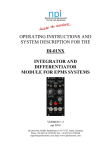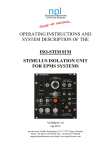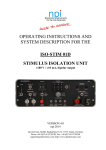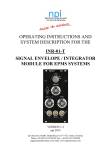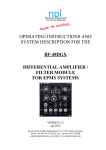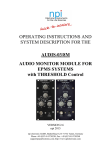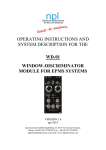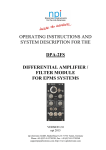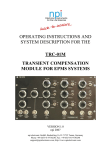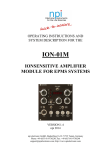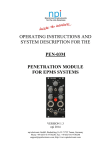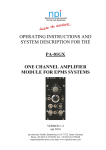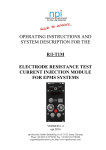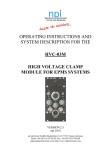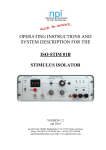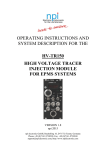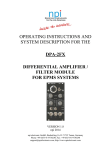Download TMR-02M Manual - NPI Electronic Instruments
Transcript
OPERATING INSTRUCTIONS AND SYSTEM DESCRIPTION FOR THE TMR-02M TIMER MODULE FOR EPMS SYSTEMS VERSION 1.5 npi 2015 npi electronic GmbH, Bauhofring 16, D-71732 Tamm, Germany Phone +49 (0)7141-9730230; Fax: +49 (0)7141-9730240 [email protected]; http://www.npielectronic.com TMR-02M User Manual ________________________________________________________________________________________________________________ Table of Contents 1. 2. Safety Regulations ............................................................................................................ 3 EPMS-07 Modular Plug-In System .................................................................................. 4 2.1. General System Description / Operation ..................................................................... 4 2.2. EPMS-07 Housing ....................................................................................................... 4 2.3. EPMS-H-07 Housing................................................................................................... 4 2.4. EPMS-E-07 Housing ................................................................................................... 4 2.5. EPMS-03 ..................................................................................................................... 5 2.6. PWR-03D .................................................................................................................... 5 2.7. System Grounding ....................................................................................................... 6 EPMS-07/EPMS-03 .................................................................................................... 6 EPMS-E-07.................................................................................................................. 6 2.8. Technical Data ............................................................................................................. 6 EPMS-07, EPMS-E-07 and EPMS-H-07 .................................................................... 6 EPMS-07 and EPMS-H-07.......................................................................................... 6 EPMS-E-07.................................................................................................................. 6 EPMS-03 ..................................................................................................................... 6 3. TMR-02M Timer Module ................................................................................................ 7 3.1. TMR-02M Components .............................................................................................. 7 3.2. System Description ...................................................................................................... 7 3.3. Description of the Front Panel ..................................................................................... 7 4. Operation .......................................................................................................................... 10 5. Technical Data .................................................................................................................. 11 ___________________________________________________________________________ version 1.5 page 2 TMR-02M User Manual ________________________________________________________________________________________________________________ 1. Safety Regulations VERY IMPORTANT: Instruments and components supplied by npi electronic are NOT intended for clinical use or medical purposes (e.g. for diagnosis or treatment of humans), or for any other life-supporting system. npi electronic disclaims any warranties for such purpose. Equipment supplied by npi electronic must be operated only by selected, trained and adequately instructed personnel. For details please consult the GENERAL TERMS OF DELIVERY AND CONDITIONS OF BUSINESS of npi electronic, D-71732 Tamm, Germany. 1) GENERAL: This system is designed for use in scientific laboratories and must be operated by trained staff only. General safety regulations for operating electrical devices should be followed. 2) AC MAINS CONNECTION: While working with the npi systems, always adhere to the appropriate safety measures for handling electronic devices. Before using any device please read manuals and instructions carefully. The device is to be operated only at 115/230 Volt 60/50 Hz AC. Please check for appropriate line voltage before connecting any system to mains. Always use a three-wire line cord and a mains power-plug with a protection contact connected to ground (protective earth). Before opening the cabinet, unplug the instrument. Unplug the instrument when replacing the fuse or changing line voltage. Replace fuse only with an appropriate specified type. 3) STATIC ELECTRICITY: Electronic equipment is sensitive to static discharges. Some devices such as sensor inputs are equipped with very sensitive FET amplifiers, which can be damaged by electrostatic charge and must therefore be handled with care. Electrostatic discharge can be avoided by touching a grounded metal surface when changing or adjusting sensors. Always turn power off when adding or removing modules, connecting or disconnecting sensors, headstages or other components from the instrument or 19” cabinet. 4) TEMPERATURE DRIFT / WARM-UP TIME: All analog electronic systems are sensitive to temperature changes. Therefore, all electronic instruments containing analog circuits should be used only in a warmed-up condition (i.e. after internal temperature has reached steady-state values). In most cases a warm-up period of 20-30 minutes is sufficient. 5) HANDLING: Please protect the device from moisture, heat, radiation and corrosive chemicals. ___________________________________________________________________________ version 1.5 page 3 TMR-02M User Manual ________________________________________________________________________________________________________________ 2. EPMS-07 Modular Plug-In System 2.1. General System Description / Operation The npi EPMS-07 is a modular system for processing of bioelectrical signals in electrophysiology. The system is housed in a 19” rackmount cabinet (3U) has room for up to 7 plug-in units. The plug-in units are connected to power by a bus at the rear panel. The plug-in units must be kept in position by four screws (M 2,5 x 10). The screws are important not only for mechanical stability but also for proper electrical connection to the system housing. Free area must be protected with covers. 2.2. EPMS-07 Housing The following items are shipped with the EPMS-07 housing: ✓ ✓ ✓ ✓ EPMS-07 cabinet with built-in power supply Mains cord Fuse 2 A / 1 A, slow (inserted) Front covers Figure 1: Left: front view of empty EPMS-07 housing. In order to avoid induction of electromagnetic noise the power supply unit, the power switch and the fuse are located at the rear of the housing (see Figure 2, right). 2.3. EPMS-H-07 Housing In addition to the standard power supply of the EPMS-07, the EPMS-H-07 has a built-in high voltage power supply. This is necessary for all MVCS / MVCC modules, the HVA-100, HVTR150 and HVC-03M modules. The output voltage depends on the modules in use. 2.4. EPMS-E-07 Housing The following items are shipped with the EPMS-E-07 housing: ✓ ✓ ✓ ✓ ✓ ✓ EPMS-E-07 cabinet External Power supply PWR-03D Power cord (PWR-03D to EPMS-E-07) Mains chord Fuse 1.6 A / 0.8 A, slow (inserted) Front covers The EPMS-E-07 housing is designed for low-noise operation, especially for extracellular and multi channel amplifiers with plugged in filters. It operates with an external power supply to minimize distortions of the signals caused by the power supply. ___________________________________________________________________________ version 1.5 page 4 TMR-02M User Manual ________________________________________________________________________________________________________________ 2.5. EPMS-03 The following items are shipped with the EPMS-07 housing: ✓ ✓ ✓ ✓ EPMS-07 cabinet with built-in power supply Mains cord Fuse 034 A / 0,2 A, slow (inserted) Front covers Figure 2: Left: front view of EPMS-03 housing. Right: rear panel detail of EPMS-03 and EPMS-07 housing. In order to avoid induction of electromagnetic noise the power supply unit, the power switch and the fuse are located at the rear of the housing (see Figure 2, right). 2.6. PWR-03D The external power supply PWR-03D is capable of driving up to 3 EPMS-E housings. Each housing is connected by a 6-pole cable from one of three connectors on the front panel of the PWR-03D to the rear panel of the respective EPMS-E housing. (see Figure 3, Figure 4). A POWER LED indicates that the PWR-03D is powered on (see Figure 3, left). Power switch, voltage selector and fuse are located at the rear panel (see Figure 3, right). Note: The chassis of the PWR-03D is connected to protective earth, and it provides protective earth to the EPMS-E housing if connected. Figure 3: Left: PWR-03D front panel view Right: PWR-03D rear panel view. Note: This power supply is intended to be used with npi EPMS-E systems only. ___________________________________________________________________________ version 1.5 page 5 TMR-02M User Manual ________________________________________________________________________________________________________________ 2.7. System Grounding EPMS-07/EPMS-03 The 19" cabinet is grounded by the power cable through the ground pin of the mains connector (= protective earth). In order to avoid ground loops the internal ground is isolated from the protective earth. The internal ground is used on the BNC connectors or GROUND plugs of the modules that are inserted into the EPMS-07 housing. The internal ground and mains ground (= protective earth) can be connected by a wire using the ground plugs on the rear panel of the instrument. It is not possible to predict whether measurements will be less or more noisy with the internal ground and mains ground connected. We recommend that you try both arrangements to determine the best configuration. EPMS-E-07 The 19" cabinet is connected to the CHASSIS connector at the rear panel. It can be connected to the SYSTEM GROUND (SIGNAL GROUND) on the rear panel of the instrument (see Figure 4). The chassis can be linked to PROTECTIVE EARTH by connecting it to the PWR-03D with the supplied 6-pole cable and by interconnecting the GROUND and PROTECTIVE EARTH connectors on the rear panel of the PWR-03D (see Figure 3). Best performance is generally achieved without connection of the chassis to protective earth. Important: Always adhere to the appropriate safety measures. Figure 4: Rear panel connectors of the EPMS-E-07 2.8. Technical Data EPMS-07, EPMS-E-07 and EPMS-H-07 19” rackmount cabinet, for up to 7 plug-in units Dimensions: 3U high (1U=1 3/4” = 44.45 mm), 254 mm deep EPMS-07 and EPMS-H-07 Power supply: 115/230 V AC, 60/50 Hz, fuse 2 A / 1 A slow, 45-60 W EPMS-E-07 External power supply (PWR-03D) 115/230 V AC, 60/50 Hz, fuse 1.6/0.8 A, slow Dimensions of external power supply: (W x D x H) 225 mm x 210 mm x 85 mm EPMS-03 Power supply: 115/230 Volts AC, 60/50 Hz, fuse 0.4 A / 0.2 A slow Maximum current supply: 500 mA Dimensions: 3U high (1U=1 3/4” = 44.45 mm), 254 mm deep, 265 mm wide ___________________________________________________________________________ version 1.5 page 6 TMR-02M User Manual ________________________________________________________________________________________________________________ 3. TMR-02M Timer Module 3.1. TMR-02M Components The following items are shipped with the TMR-02M system: ✓ Timer module for the EPMS-07 system ✓ User manual 3.2. System Description The TMR-02M was designed as an easy-to-use device for generating square pulses of fixed amplitude (TTL, +5 V) and variable length. The TMR-02M has two digital switches to set PULSE duration and DELAY time. The TMR02M can be used continuously or for a selectable number of cycles. A switch allows manual start (and stop while cycling), but the unit can also be operated using an external TRIGGER. The TRIGGER output is used to control external devices, e.g. an oscilloscope. 3.3. Description of the Front Panel Figure 5: TMR-02M front panel view ___________________________________________________________________________ version 1.5 page 7 TMR-02M User Manual ________________________________________________________________________________________________________________ (1) PULSE (x 0.01 ms) switch 5-digit thumb wheel switch to set the duration of the PULSE, minimum pulse width 10 µs, maximum pulse width 999.99 ms. (2) DELAY (x 0.01 ms) switch 5-digit thumb wheel switch to set a delay time, minimum delay time 10 µs, maximum delay time 999.99 ms.. The delay time is the time from the rising edge of the trigger TTL signal to the beginning of the rising edge of the PULSE (see also Figure 6). Note: If both thumb wheel switches are set to 00000, a short pulse with 1 µs duration will be generated! (3) CYCLES switch Switch for setting the number of desired cycles (1 to 999). Note: At the start of each train of cycles a RESET is executed, i.e. the TMR will be reset immediately after a start signal comes, either via manual switch or via TTL signal. For instance, if you preset 10 cycles and you press start or a TTL pulse is applied, the timer is reset to zero, 10 cycles will be executed and the TMR stops still showing "10" at the display. Upon the next start signal (via switch or TTL) the timer is reset again and 10 cycles will be executed. Note: If the thumb wheel switch is set to 000 and switch #4 is set to REPETITIVE, 1 cycle will be generated! (4) REPETITIVE / CONTINUOUS switch Switch for setting the operation mode of the TMR-02M. REPETITIVE: The timer cycles repetitively pulses: The number cycles is of set by CYCLES switch #3. CONTINUOUS: The timer cycles pulses continuously as long as the RESET / STOP switch is pressed. (5) TIMER OUT (TTL) connector BNC connector providing the timed TTL signal (see also #1 and #2, Figure 5). The TTL at this connector is HI (+5 V) for the duration of the pulse. (6) TRIGGER OUT (TTL) connector BNC connector providing a TRIGGER signal for triggering an external device, e.g. an oscilloscope at the beginning of each cycle. The signal amplitude (TTL, +5 V), the signal length is 1 µs. (7) TRIGGER IN (TTL) connector BNC connector for connecting an external TRIGGER device, minimum length: 10 µs. ___________________________________________________________________________ version 1.5 page 8 TMR-02M User Manual ________________________________________________________________________________________________________________ (8) RESET / STOP switch Switch for stopping the timer. RESET: the timer is stopped and the CYCLE COUNTER is set to zero. STOP: the timer is stopped and the CYCLE COUNTER shows the number of cycles which had been carried out. If started again with switch #9 the CYCLE COUNTER continues to count. Note: At the start of each train of cycles a RESET is executed, i.e. the TMR will be reset immediately after a start signal comes, either via manual switch or via TTL signal. For instance, if you preset 10 cycles and you press start or a TTL pulse is applied, the timer is reset to zero, 10 cycles will be executed and the TMR stops still showing "10" at the display. Upon the next start signal (via switch or TTL) the timer is reset again and 10 cycles will be executed. (9) START / TRIG IN BNC switch Switch for setting the kind of starting. START: The timer is started by pressing the switch to this position. TRIG IN BNC: The timer is started by a TTL HI signal applied to the TRIG IN BNC. Note: To prevent unwanted cycle starts the START function of the switch has a built-in debouncing circuit. As a result the minimum time between two manually switched START events is ca. 2 s. (10) CYCLE COUNTER LED LED indicating the number of cycles which had been carried out since the first start. In CONTINUOUS mode the LED counts continuously. ___________________________________________________________________________ version 1.5 page 9 TMR-02M User Manual ________________________________________________________________________________________________________________ 4. Operation The TMR-02M module can be started either manually by pushing START (#9, Figure 5)or by a TTL HI signal (rising edge) at TRIGGER IN (TTL) (#7, Figure 5). This signal must be at least 10 µs. The time course of the signals at input and outputs is illustrated in Figure 6. Figure 6: scheme of operation At the beginning of the DELAY time a TTL signal (+5 V, 1 µs) is generated at TRIGGER OUT. This TTL signal can be used to trigger an oscilloscope. After the DELAY, the PULSE starts immediately. After the end of the PULSE the second cycle begins and so on, i.e. the timelag between the pulses is determined by the DELAY (x 0.01 ms) switch (#2, Figure 5). ___________________________________________________________________________ version 1.5 page 10 TMR-02M User Manual ________________________________________________________________________________________________________________ 5. Technical Data TMR-02M PULSE (x 0.01 ms) switch: DELAY (x 0.01 ms) switch: CYCLES switch: TIMER OUT: TRIGGER OUT: TRIGGER IN: 5 digits thumb wheel, 0.01 to 999.99 ms, digital 5 digits thumb wheel, 0.01 to 999.99 ms, digital 3 digits thumb wheel, 1 to 999 BNC connector, TTL signal BNC connector, TTL signal, 1 µs BNC connector, TTL signal, 10 µs minimum Size: front panel: 12 HP (60.6 mm) x 3U (128,5 mm), 7” (175 mm) deep ___________________________________________________________________________ version 1.5 page 11











